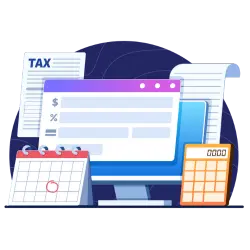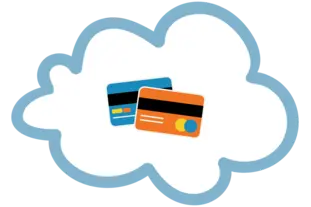For those wondering if Shopify collects a sales tax, we have news to share with you.
These days, there are plenty of options for buying online. In fact, it’s become the norm, at least compared to making purchases at a physical storefront. It used to be that businesses only paid sales tax in the state where they sold goods and services. Today, eCommerce companies are not only responsible for business conducted in their home state but also for collecting and remitting taxes for states where they intend to ship goods.
Do you use Shopify? Does your customer base extend across state lines? Are you curious about tax technicalities related to selling outside of your home state? If you answered “yes” to any of those questions, this handy guide can help you meet your tax obligations with minimal fuss.
Sales Taxes and Shopify: How Does It All Work?
As of 2018, tax laws require sellers without a physical merchant presence to collect and pay sales tax for all items sold. This is where the dual concepts of “nexus” and “economic nexus” become applicable.
Let’s unpack those terms. A nexus is a link to a state that requires you to collect and remit sales tax. This can encompass everything from operating a warehouse or storefront to employing local staff. The criteria for establishing nexus varies on a state-by-state basis. Economic nexus, on the other hand, refers to the collection and remittance of sales tax based on volume while also accounting for shipping that may take place outside the state where the merchant claims residence[1]Journal of Accountancy. “A practical guide to economic nexus”. Accessed on July 2, 2024 .
Unlike major companies like eBay or Amazon, Shopify is not in the business of automatically collecting or remitting sales tax. It is not technically a marketplace facilitator, which means it is not subject to laws that require platforms like Amazon or eBay to handle sales tax for their customers. Therefore, Shopify sellers must manage and remit their sales tax in states where this procedure applies.
As we said, the rules for this sort of thing vary from state to state. As a business owner looking to protect your interests, you should be sure to obtain a local sales tax permit before configuring your tax collections. Collecting sales tax without a license is illegal and may subject the party in question to legal penalties.
What Shopify Does for Your Taxes
When preparing to launch your eCommerce store, you must collect, register, and pay sales tax in each state where your business has a physical presence. We recommend monitoring sales transactions and carefully reviewing economic nexus laws to ensure full compliance.
Properly managing your taxes is essential to operating any online business. While Shopify has options that allow you to streamline tax collection and reporting, you’ll still have to deal with some aspects of your business plan independently.
Let’s look at the aspects of reporting that Shopify does cover:

Sales Tax Collection
With Shopify, merchants can utilize automated tools to help them better manage the nuances of sales tax collection. While this is integral for the sake of compliance, the process also ensures that there will be no interruptions to your established cash flow. By setting up tax rates within Shopify, the platform calculates the appropriate tax to charge for each order based on the customer’s location and the merchant’s nexus. This way, merchants can configure tax overrides and employ reports to assess all taxes collected.
While Shopify cannot manage registrations related to tax collections, it does come equipped with enough integrations and guidelines (via assorted tax apps) to help the merchant stay on track.

Separate Taxes From Product Price
Transparency is invaluable for preserving trust with your customer base. Knowing this, Shopify allows users to separate the sales tax from the price of any listed product. This degree of clarity reduces the possibility of customer confusion, especially in regions where customers are used to making purchases without factoring in taxes.
To allow Shopify to display prices sans tax, adjust your store preference settings as needed. Proper configuration ensures that prices are displayed according to local regulations and customer expectations. This helps foster trust with your regular shoppers while ensuring that you, the merchant, remain compliant.
Your Taxes: What Shopify Won’t Do
While Shopify provides a sturdy foundation for tax management, it is no substitute for a well-thought-out tax solution. Knowing how to differentiate between the two is critical in this regard. Merchants looking to be fully tax-compliant would be wise to familiarize themselves with the limits of a platform like Shopify. With that in mind, here are some things Shopify won’t do regarding your taxes.

No Tax Threshold Notifications
Shopify does not provide automated notifications for tax thresholds. Merchants must proactively monitor sales and stay informed about state-specific thresholds so as to avoid missing pertinent tax nexus developments.
How does one stay on top of sales numbers and relevant, state-specific minutiae? Start by regularly reviewing your tax liabilities. If necessary, consider contacting a third-party tax service for assistance. As we alluded to earlier, it pays to be vigilant with these details, as any oversight could lead to penalties for non-compliance.

No Native Tax Report Filing
Shopify is not responsible for filing its merchant’s tax reports. However, the platform does offer options to assist merchants in preparing their tax filings. These reports provide a thorough summary of taxed orders and are essential for accurately completing and submitting your return. Please organize these reports into the applicable tax forms; again, seeking outside assistance via third-party services that can integrate with Shopify for direct filing assistance is totally okay.
How to Collect Sales Tax Within Shopify
To set up your Shopify store with sales tax, follow these steps:

Step 1: Define the Sales Tax Locations
To properly ensure that Shopify collects sales tax, you must first determine the states where this is a legal requirement. Start with your home state before adding any applicable nexus states. The steps are as follows:
- Go to the Shopify dashboard home page.
- Click on “Settings” at the bottom left.
- Select “Taxes and Duties.”
- Under “Manage sales tax collection,” click on the United States.
- Select “Collect Sales Tax.”
In the dropdown menu, select the states where you must collect taxes due to physical or economic presence. Have your sales Tax ID (or federal employment ID number) ready. If you are having difficulty locating your Tax ID, there are methods of recourse to consider.

Step 2: Classify Products Into Appropriate Tax Categories
It is time to categorize your products for tax collection. If you have uncategorized products, Shopify will let you know how many of these products will need your attention.
Shopify spares products from taxation when applicable by correctly identifying the states where your taxes will be collected. Product categorization incorporates regional rules, thus minimizing the need for manual tax overrides.

Step 3: Configure Your Sales Tax Settings for Shipping
Shopify handles shipping and sales tax collection by automatically adding sales tax in appropriate regions. In exceptional cases, you may need to apply overrides as needed. In order to take advantage of Shopify’s Sales Tax Liability Dashboard for an overview of your tax obligations:
- Log in to your Shopify admin panel, navigate to Settings, and select “Taxes.”
- Under the United States, click on “Manage.”
- Locate the “Manage sales tax liability” section and select “Show all liabilities” on the right.
Upon completing these steps, you will be directed to the sales tax liability dashboard, where you’ll click “Show details” to view Shopify’s estimate of your proximity to the sales tax threshold.
While all this is helpful, we still encourage merchants to consult a certified tax expert for the most accurate results. Shopify’s economic nexus calculator is limited in that it only considers sales authorized through the Shopify platform. In other words, it does not factor in auxiliary sales channels or take multiple platforms into account.

Step 4: Manually Adjust As Needed
Beyond automatic configurations, Shopify requires users to specify which items in their store are taxable in the states where they are registered. Not every product will be subject to sales tax; an eCommerce business, for instance, should not have to collect sales tax on things like vouchers or gift cards.

Step 5: Input Your Warehouse Locations
In order to complete this step, go to “Settings” and select “Locations.” Once you’ve done this, you will then input the addresses of the warehouses in charge of dispatching your orders. This information helps Shopify determine the appropriate shipping rates and sales tax. Remember, these things are often contingent on external and circumstantial factors, like if the shipment is located in the same state as the warehouse. To guarantee the most precise tax calculations possible, merchants should ideally possess the acumen that allows them to distinguish between office locations and fulfillment centers. It’s a minute detail, but in this case, an important one.

Step 6: Enter Information for Clients Exempt From Sales Tax
Finally, while it may sound counterintuitive to some, Shopify merchants may or may not need to apply taxes to every customer. Familiar tax-exempt customers include government agencies and nonprofits, as well as sellers purchasing goods for resale through Shopify.
More often than not, these are recurring transactions. Before you cease collection of your requisite sales tax, do your due diligence and ensure that you have obtained a tax-exempt certificate as it applies to the customers in question. To designate these customers as tax-exempt, go to your Shopify store, navigate to “Customers,” and select the “Add Customer” option. Once you’ve done this, be sure to uncheck the “Collect Tax” option. Should you deem it necessary, you can also add a note that provides a detailed explanation for this specific exemption. While this last part is not strictly necessary, we find that it’s better to be safe than sorry when dealing with something as fundamentally serious as tax liability.
Shopify Sales Tax by State

Different states have different regulations for different tax requirements. Shopify merchants must not only comply with these requirements but also understand why they are doing so. Shopify is rich in technical resources, and the platform comes outfitted with tools designed to help users determine the location of their nexus. While some merchants might assume that the state where their product is bound maintains sole taxing rates, the actual rate may or may not be determined by the shipment’s origin or destination. Here are a few external factors to consider regarding Shopify’s sales tax regulations in different states:
- The seller’s location determines sales taxes based on origin-based transactions. This becomes applicable when a merchant ships goods to two destinations within the same state; an example would be shipping a package from Sacramento to Los Angeles.
- Destination-sourced sales are taxed based on the location where the buyer receives the item. For instance, a location-based tax rate would still apply if goods were being shipped outside Texas into Texas.
Most states rely on destination sourcing for sales tax purposes, while others use a series of sourcing regulations.

Sales Tax Requirements per State
Every state has its own unique tax rules for designated eCommerce businesses[2]Sales Tax Institute. “Economic Nexus State by State Chart”. Accessed on July 2, 2024.. Correspondingly, most states require sellers to collect sales tax if they exceed a certain financial threshold: typically $100,000 or 200 transactions annually. However, states like California, Massachusetts, New York, and Texas tend to maintain higher limits (up to $500,000). Failure to reach these thresholds can potentially prohibit merchants from tax collection in other states.
Idaho, Iowa, North Dakota, and Tennessee all require online merchants to collect sales tax once their annual gross revenue has reached a threshold of $100,000. This statute holds regardless of the overall transaction count. However, specific states tend to maintain lower thresholds. For instance, Oklahoma’s nexus starts at $10,000 in sales. Conversely, Kansas requires sellers to collect tax upon completion of their first sale.
Here are some less common state laws that merchants should nevertheless remain aware of:
Alabama
The nexus threshold in Alabama is $250,000. Since that state relies on a destination-based tax system, out-of-state sellers must collect and remit Alabama sales tax when sales to local residents surpass the aforementioned amount.
California
California’s sales tax is remarkably high at 7.25%, with the possibility of additional local taxes[3]CA.Gov. “Know Your Sales and Use Tax Rate”. Accessed on July 2, 2024.. Since April 2019, retailers with over $500,000 in annual taxable sales have been designated as having economic nexus. It should also be noted that digital products are not taxable in California.
Mississippi
Vendors with over $250,000 in annual sales must pay sales tax. This includes the sale of digital products[4]Numeral. “Mississippi Sales Tax Guide 2024: Compliance, Rates, and Regulations for Businesses”. Accessed on July 2, 2024..
New York
It has been mandated that businesses that generate at least $500,00 in annual gross revenue via at least 100 transactions conducted over twelve months must establish economic nexus and thereby collect sales tax. Businesses that fail to meet these thresholds are not obligated to remit sales tax to the state. Similar to California’s relationship with digital goods, apparel and footwear items priced under $110 are not subject to sales tax in the state of New York[5]New York State Department of Taxation and Finance. “Clothing and Footwear Exemption.” Accessed on July 2, 2024 ..
Texas
Texas operates from an origin-based sales tax system. Basically, sellers are not required to collect Texas sales tax on items shipped anywhere outside the state’s borders. However, if these same folks sell to Texas customers, they must charge both state and local sales taxes (based on their business address).
Simplify Sales Tax With the Right Payment Provider
What can you do to ensure that your online business remains compliant? How do you avoid penalties? How does one thrive in our fast-paced, competitive online marketplace?
Staying up-to-date on local and federal tax laws helps. Make sure you’re offering your buyers plenty of different eCommerce payment options. When in doubt, make use of Shopify’s sales tax reporting feature. If you run into any roadblocks, consult with a trusted tax professional.
In conclusion, taking these proactive steps will not only keep your online business compliant but also position you for long-term success in the ever-evolving world of eCommerce.







